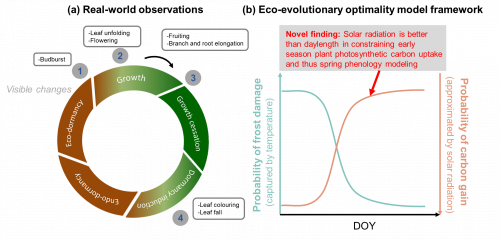Conceptual illustration of real-world observations (a) and the eco-evolutionary optimality model framework (b) for spring phenology. (a) Key phenostages (growth, growth cessation, dormancy induction, endo-dormancy, and eco-dormancy) and visible transitions (in the black rectangle) from spring to winter. (b) Eco-evolutionary optimality model framework: the red line represents the probability of carbon gain, approximated by solar radiation; the blue line represents the probability of frost damage, approximated by temperature. The novel finding highlights that solar radiation is a better constraint than daylength for early season plant photosynthetic carbon uptake, thus improving spring phenology modeling.
An international team of scientists from Hong Kong, Mainland China, and the United States, led by Dr. Jin Wu from the School of Biological Sciences at HKU, has made a breakthrough in understanding and modeling the impact of climate change on spring phenology in temperate ecosystems. The study, published in the Remote Sensing of Environment journal, examined around 20 years of environmental data and spring phenology metrics across 108 sites in the Northern and Eastern United States.
Spring phenology, or the timing of natural leaf flushing events in spring, is highly sensitive to climate change and can influence various terrestrial surface biophysical processes. Although several models have been developed to predict spring phenology based on temperature and photoperiod, comprehensive evaluations over large landscapes and long periods remain limited.
The study evaluated three prognostic models (Growing Degree Date, Sequential, and optimality-based) and assessed their associations with environmental factors such as soil moisture, rainfall, and solar radiation. The researchers found that all models showed good capability in characterizing spring phenology, with solar radiation playing a significant role in model residuals.
By including solar radiation in the revised models, the researchers achieved a 22.08% reduction in model residuals (approximated by RMSE), indicating that solar radiation better constrains early growing season plant photosynthesis than photoperiod. This supports the hypothesis that spring phenology acts as an adaptive strategy to maximize photosynthetic carbon gain while minimizing frost damage risk.
“The findings highlight the underappreciated importance of solar radiation in constraining spring phenology of temperate ecosystems and suggest ways to improve spring phenology modeling and other phenology-related ecological processes,” said Ms. Yating Gu, the leading author of the paper and PhD candidate of Dr. Jin Wu’s lab. “This breakthrough could contribute to a better understanding and modeling of the ecosystem’s sensitivity response to climate change, and offer an improved way to quantify climate change impacts on our natural ecosystems,” added Dr. Jin Wu.
In the next step, Ms. Gu and Dr. Wu plan to extend the similar modeling analysis to global temperate regions, with an aim to explore the generalizability and novel mechanisms underlying the spring phenology regulation around the world. The relevant mechanisms will be integrated with large-scale terrestrial biosphere models, by which the researchers can further assess the associated large-scale carbon feedbacks if the model with/without including the right spring phenology mechanism.
The recent publication can be found here


